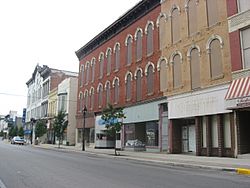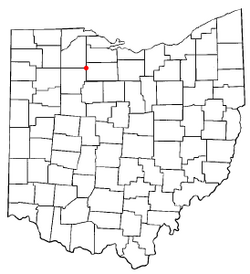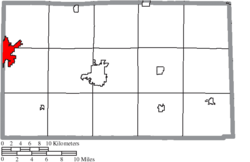Fostoria, Ohio facts for kids
Quick facts for kids
Fostoria, Ohio
|
|
|---|---|

Main Street in downtown Fostoria
|
|

Location of Fostoria, Ohio
|
|

Location of Fostoria in Seneca County
|
|
| Country | United States |
| State | Ohio |
| Counties | Seneca, Hancock, Wood |
| Area | |
| • Total | 7.76 sq mi (20.10 km2) |
| • Land | 7.54 sq mi (19.53 km2) |
| • Water | 0.22 sq mi (0.56 km2) |
| Elevation | 781 ft (238 m) |
| Population
(2010)
|
|
| • Total | 13,441 |
| • Estimate
(2019)
|
13,225 |
| • Density | 1,753.51/sq mi (677.04/km2) |
| Time zone | UTC-5 (Eastern (EST)) |
| • Summer (DST) | UTC-4 (EDT) |
| ZIP code |
44830
|
| Area code(s) | 419, 567 |
| FIPS code | 39-28014 |
| GNIS feature ID | 1064668 |
Fostoria ( foss-TORR-EE-ə) is a city located at the convergence of Hancock, Seneca, and Wood counties in the northwestern part of the U.S. state of Ohio. It is approximately 40 miles (64 km) south of Toledo and 90 miles (140 km) north of Columbus.
The city is known for its railroads, as approximately 100 trains pass through the city each day. The city is often visited by railfans, and a railroad viewing park, constructed in 2013 (dedicated 14 November 2013) hosts many railfans every day in a purpose built viewing platform. Fostoria was also the home for over a dozen glass factories during the end of the 19th century. The glass factories were established in Fostoria because of the discovery of natural gas in the area. As the gas supply became depleted, many of the factories closed or moved—including the Fostoria Glass Company. Fostoria's most famous citizen is Charles Foster (son of the man who helped establish Fostoria), who became governor of Ohio.
The community grew substantially during the end of the 19th century, coinciding with the northwest Ohio gas boom. Typical of Rust Belt cities, Fostoria peaked in size in 1970. The population was 13,441 at the 2010 census.
Contents
Name and general background
Fostoria was created in 1854 with the merger of the communities of Rome and Risdon. The combination of the two communities' Methodist churches, on land donated by Charles W. Foster, led to the merger. To show their appreciation for Mr. Foster's generosity, the new community was named Fostoria. Charles W. Foster's son, Charles, became one of Fostoria's most famous citizens—becoming the 35th governor of Ohio and U.S. Secretary of the Treasury under President Benjamin Harrison.
Fostoria is known for its glass heritage and railroads: two CSX main lines and one NS main line intersect in downtown Fostoria, an area called the "Iron Triangle." A natural gas boom in the 1880s, the railroad lines, and recruiting efforts by the community caused Fostoria to become home for numerous glass factories, including the Mambourg Glass Company (the city's first glass factory), the Fostoria Glass Company, the Seneca Glass Company, the Novelty Glass Company, and others.
Although the boom in gas and glass is long over, railroads continue to be important to the community. More than 100 trains passed through Fostoria each day. The Fostoria Railroad Preservation Society, aided by a $815,760 grant from the Ohio Department of Transportation, completed a train viewing park in 2013 to help capitalize on the thousands of railfans who visit yearly.
Geography
Fostoria is located at 41°9′33″N 83°24′55″W / 41.15917°N 83.41528°W (41.159243, -83.415239).
According to the United States Census Bureau, the city has a total area of 7.77 square miles (20.12 km2), of which 7.55 square miles (19.55 km2) is land and 0.22 square miles (0.57 km2) is water.
Demographics
| Historical population | |||
|---|---|---|---|
| Census | Pop. | %± | |
| 1860 | 1,027 | — | |
| 1870 | 1,733 | 68.7% | |
| 1880 | 3,569 | 105.9% | |
| 1890 | 7,070 | 98.1% | |
| 1900 | 7,730 | 9.3% | |
| 1910 | 9,597 | 24.2% | |
| 1920 | 9,987 | 4.1% | |
| 1930 | 12,790 | 28.1% | |
| 1940 | 13,453 | 5.2% | |
| 1950 | 14,351 | 6.7% | |
| 1960 | 15,732 | 9.6% | |
| 1970 | 16,037 | 1.9% | |
| 1980 | 15,743 | −1.8% | |
| 1990 | 14,983 | −4.8% | |
| 2000 | 13,931 | −7.0% | |
| 2010 | 13,441 | −3.5% | |
| 2019 (est.) | 13,225 | −1.6% | |
| Sources: | |||
2010 census
As of the census of 2010, there were 13,441 people, 5,417 households, and 3,432 families living in the city. The population density was 1,780.3 inhabitants per square mile (687.4/km2). There were 6,225 housing units at an average density of 824.5 per square mile (318.3/km2). The racial makeup of the city was 84.1% White, 6.4% African American, 0.1% Native American, 0.4% Asian, 4.3% from other races, and 4.7% from two or more races. Hispanic or Latino of any race were 11.5% of the population.
There were 5,417 households, of which 33.0% had children under the age of 18 living with them, 39.1% were married couples living together, 17.3% had a female householder with no husband present, 7.0% had a male householder with no wife present, and 36.6% were non-families. 31.3% of all households were made up of individuals, and 13.7% had someone living alone who was 65 years of age or older. The average household size was 2.42 and the average family size was 2.97.
The median age in the city was 37.9 years. 26% of residents were under the age of 18; 8.3% were between the ages of 18 and 24; 23.9% were from 25 to 44; 25.8% were from 45 to 64; and 16% were 65 years of age or older. The gender makeup of the city was 47.3% male and 52.7% female.
Transportation
The city is served by one airport, called Fostoria Metropolitan Airport. Fostoria was served by the Three Rivers Amtrak Service which ran between Chicago and New York City on CSX's B&O line until train service there ended in March 2005.
The city is the site where the Norfolk Southern Railway's ex-Nickel Plate Road mainline crosses the previously mentioned CSX ex-B&O and ex-C&O lines. The three crossings form a triangle, with the site known as the "Iron Triangle." The area is a popular spot for railfans and has a park located in the center between the three mainlines.
Notable people
- Charlie Earl, former Ohio State Representative, Libertarian Party candidate in the 2014 Ohio gubernatorial election
- Charles Foster, son of Fostoria's namesake, former governor of Ohio, former United States Secretary of the Treasury
- Edward R. Hays, soldier, lawyer and politician (Republican U.S. representative representing the Iowa's 7th congressional district from 1890 to 1891)
- Micah Hyde, football player
- Grant Jackson, baseball player
- Tony Lucadello, baseball scout
- Damon Moore, football player
- John Quinn, art collector
- Gene Sharp, nonviolent action scholar and Nobel Peace Prize Nominee
- Harold L. Yochum, American theologian, church leader and ninth President of Capital University
See also
 In Spanish: Fostoria (Ohio) para niños
In Spanish: Fostoria (Ohio) para niños

